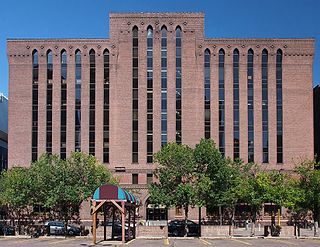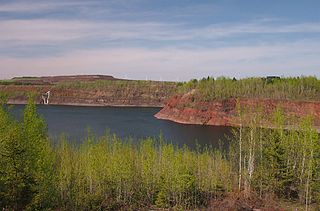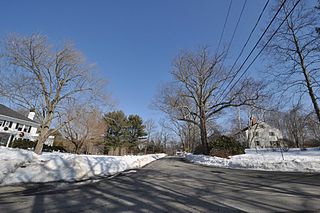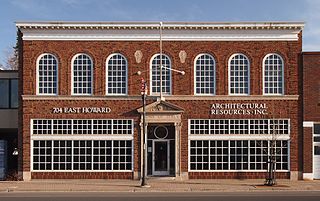
The Mesabi Iron Range is a mining district in northeastern Minnesota following an elongate trend containing large deposits of iron ore. It is the largest of four major iron ranges in the region collectively known as the Iron Range of Minnesota. First described in 1866, it is the chief iron ore mining district in the United States. The district is located largely in Itasca and Saint Louis counties. It has been extensively worked since 1892, and has seen a transition from high-grade direct shipping ores through gravity concentrates to the current industry exclusively producing iron ore (taconite) pellets. Production has been dominantly controlled by vertically integrated steelmakers since 1901, and therefore is dictated largely by US ironmaking capacity and demand.

The Hull–Rust–Mahoning Open Pit Iron Mine in Hibbing, Minnesota, United States, is the largest operating open-pit iron mine in Minnesota. The pit stretches more than three miles (5 km) long, two miles (3 km) wide, and 535 feet (163 m) deep. It was established in 1895 and was one of the world's first mechanized open-pit mines.

B'nai Abraham Synagogue is a former synagogue in Virginia, Minnesota, United States. It was constructed in 1909 as the first purpose-built synagogue on the Iron Range. It served as the heart of the local Jewish community in the early 20th century. The building was listed on the National Register of Historic Places in 1980 for its local significance in the themes of religion and social history. It was nominated for attesting both to the ethnic diversity of the Iron Range and to the commonality of its immigrant groups maintaining cohesion around religious centers.

Butler Square is a former warehouse and office building in Minneapolis, Minnesota, United States. The building is located within the Minneapolis warehouse district and was listed on the National Register of Historic Places in 1971. It is significant for its restrained Chicago School design by major Minneapolis architect Harry Wild Jones, and as a leading example of the older warehouse/office buildings in Minneapolis–Saint Paul. Jones designed other buildings in Minneapolis such as the Minneapolis Scottish Rite Temple, Calvary Baptist Church, the Lakewood Cemetery Chapel, and the Washburn Park Water Tower.

Mountain Iron Mine is a former mine in Mountain Iron, Minnesota, United States. Opened in 1892, it was the first mine on the Mesabi Range, which has proved to be the largest iron ore deposit ever discovered in the United States. Mining operations at the site ceased in 1956. The bottom of the open-pit mine has filled with water but its dimensions are readily visible. The city maintains an overlook in Mountain Iron Locomotive Park.

This is a list of the National Register of Historic Places listings in Dakota County, Minnesota. It is intended to be a complete list of the properties and districts on the National Register of Historic Places in Dakota County, Minnesota, United States. Dakota County is located in the southeastern part of the U.S. state of Minnesota, bounded on the northeast side by the Upper Mississippi River and on the northwest by the Minnesota River. The locations of National Register properties and districts for which the latitude and longitude coordinates are included below, may be seen in an online map.

Manganese is a ghost town and former mining community in the U.S. state of Minnesota that was inhabited between 1912 and 1960. It was built in Crow Wing County on the Cuyuna Iron Range in sections 23 and 28 of Wolford Township, about 2 miles (3 km) north of Trommald, Minnesota. After its formal dissolution, Manganese was absorbed by Wolford Township; the former town site is located between Coles Lake and Flynn Lake. First appearing in the U.S. Census of 1920 with an already dwindling population of 183, the village was abandoned by 1960.

This is a list of the National Register of Historic Places listings in Saint Louis County, Minnesota. It is intended to be a complete list of the properties and districts on the National Register of Historic Places in Saint Louis County, Minnesota, United States. The locations of National Register properties and districts for which the latitude and longitude coordinates are included below, may be seen in an online map.

There are 75 properties listed on the National Register of Historic Places in Albany, New York, United States. Six are additionally designated as National Historic Landmarks (NHLs), the most of any city in the state after New York City. Another 14 are historic districts, for which 20 of the listings are also contributing properties. Two properties, both buildings, that had been listed in the past but have since been demolished have been delisted; one building that is also no longer extant remains listed.

Colonial Hall and Masonic Lodge No. 30 consists of two historic buildings located at 1900 3rd Avenue, South in Anoka, Minnesota. Both were owned by Anoka Lodge No 30 AF & AM, which was chartered on October 25, 1859. Colonial Hall, also known as the Aldrich House for its association with the house's first owners and occupants, local medical and civil leaders Dr. Alanson and Dr. Flora Aldrich, is a two-story wooden building built in 1904 in a combination of Colonial Revival and Greek Revival styles by local renowned architect Fredrick Marsh. The Aldrich House was purchased by the Anoka Lodge in 1921, and in 1922, construction began on the present two-story redbrick Masonic temple, which is located behind but to the north of the Colonial Hall. Designed and built in the Georgian Revival style, it was completed and occupied in 1923.

Hibbing High School is a public grade 7–12 high school in Hibbing, Minnesota, United States. It was built from 1920 to 1922 as the entire city relocated two miles (3 km) south to make way for the expanding Hull–Rust–Mahoning Mine. The lavish Tudor Revival building was constructed at a cost of about $3.9 million, becoming known as the "castle in the woods" and—thanks to its polished brass fixtures—the "school with the golden doorknobs". The project was bankrolled by the mining industry, which wanted to make the move more palatable for those being displaced. It also satisfied immigrants' desire for their children's education.

The Jewell Town District of South Hampton, New Hampshire, encompasses a colonial-era industrial village with a history dating to 1687. It is centered at the junction of West Whitehall and Jewell Streets, which is just south of a bend in the Powwow River, the source of the power for the mills that were built here. The area was settled in 1687 by Thomas Jewell, and by the early 19th century included a variety of mills as well as a bog iron works. The district now includes only remnants of its industrial past, and features a collection of 18th and early-19th century residential architecture. The district was listed on the National Register of Historic Places in 1983.

The Arthur Perkins House is a historic house at 242 South Main Street in Rutland, Vermont. Built in 1915, it is a Colonial Revival brick house with unusual cast and poured concrete trim elements. It was built for the owner of a nearby clay processing business. The house was listed on the National Register of Historic Places in 1988.

The Virginia–Rainy Lake Lumber Company Office is a former office building in Virginia, Minnesota, United States. It was built around 1907 as the headquarters for the Virginia–Rainy Lake Lumber Company, the largest lumber company in the Upper Midwest in the early 20th century. The building was listed on the National Register of Historic Places in 1980 for its state-level significance in the theme of industry. It was nominated for representing one of the Iron Range's few major industries aside from mining.

The Sons of Italy Hall is the former clubhouse of an Italian-American fraternal organization in Hibbing, Minnesota, United States. It was built in 1930 and stayed active until 1968. The hall was listed on the National Register of Historic Places in 1980 for its local significance in the theme of social history. It was nominated for reflecting the diversity of the Iron Range immigrant population and the unique way Hibbing's Italian community organized around clubs rather than churches.

Hibbing City Hall is the seat of local government for Hibbing, Minnesota, United States. It was built in Colonial Revival style in 1922. Hibbing City Hall was listed on the National Register of Historic Places in 1981 for its state-level significance in the themes of architecture and politics/government. It was nominated for being one of northern Minnesota's most architecturally distinctive public buildings and the longstanding seat of government for one of the largest communities of the Iron Range.

The East Howard Street Commercial Historic District is a historic business district in Hibbing, Minnesota, United States. It comprises both sides of East Howard Street along the four blocks between 1st and 5th Avenues. It was the new business district designed and built for Hibbing by the Oliver Iron Mining Company from 1920 to 1921, when the company arranged to move the city a mile south to expand the Hull–Rust–Mahoning Open Pit Iron Mine. The district was listed on the National Register of Historic Places in 1993 for its local significance in the theme of community planning and development. It was nominated as a key portion of Hibbing that represents the efforts of the Oliver Iron Mining Company to relocate the entire town, and the economic importance of iron mining on the Mesabi Range.

The W. T. Bailey House is a historic house in Virginia, Minnesota, United States. It was built around 1921 in Spanish Colonial Revival style for the founder of Bailey Lumber Mill, the city's second-largest lumber company. The house was listed on the National Register of Historic Places in 1980 for its local significance in the themes of architecture, commerce, and industry. It was nominated for its association with a prominent businessman in one of Virginia's primary industries, and for illustrating the correlation between "wealth and prominence in the mining and lumbering regions and large and architecturally distinctive residences".

The Androy Hotel is a former hotel building in Hibbing, Minnesota, United States. It was built in 1921 by the Oliver Iron Mining Company to anchor the city's new business district, which was being relocated so the Hull–Rust–Mahoning Open Pit Iron Mine could expand. The Androy Hotel was listed on the National Register of Historic Places in 1986 for its local significance in the themes of architecture and industry. It was nominated for being a good example of a large, Renaissance Revival hotel built to serve a growing mining community. When the East Howard Street Commercial Historic District was designated in 1993, the Androy Hotel was listed as a contributing property.

The Andrew G. Anderson House is a historic house in Hibbing, Minnesota, United States. It was built in 1920 for Andrew "Bus Andy" Anderson, a pioneer in the intercity bus service industry. The house was listed on the National Register of Historic Places in 1980 for its local significance in the themes of architecture and transportation. It was nominated for its association with Anderson and its status as one of the most lavish residences in the Hibbing area.

























